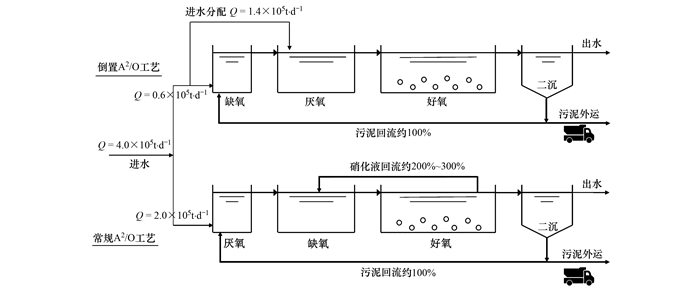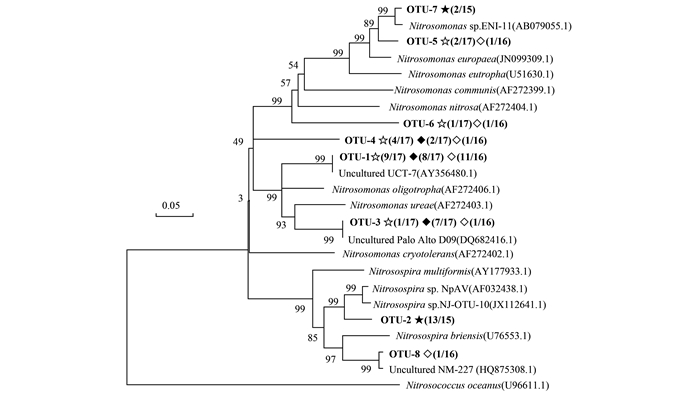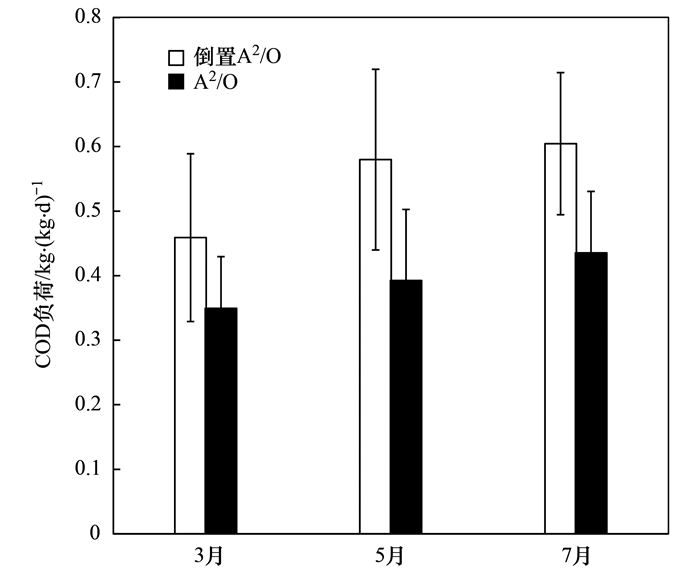2. 中国科学院生态环境研究中心环境水质学国家重点实验室, 北京 100085
2. State Key Laboratory of Environmental Aquatic Chemistry, Research Center for Eco-Environmental Sciences, Chinese Academy of Sciences, Beijing 100085, China
A2/O工艺(厌氧/缺氧/好氧)通过在不同工艺单元中创建适宜不同重要功能种群(如硝化菌、反硝化菌和聚磷菌等)的生存环境, 以保持种群数量的总体动态平衡, 从而保证工艺对碳、氮、磷具有较高的整体去除能力[1].为了减缓其在运行中发生的聚磷种群与反硝化种群间的碳源竞争现象, 倒置A2/O工艺(缺氧/厌氧/好氧)通过取消混合液回流、交换厌氧与缺氧单元顺序等工艺变化, 有针对性地增强了工艺生物除磷效果, 但在低温运行条件下却易出现氨氮(NH4+-N)去除性能下降的现象[2, 3].
NH4+-N完整的生物去除过程主要由氨氧化菌(AOB)和亚硝酸盐氧化菌(NOB)分步承担.由于氨氧化为主要限速步骤, 因此在一定条件下, AOB中优势种属的数量及其氨氧化能力可以被看作系统NH4+-N去除能力的代表; 而系统NH4+-N去除性能的下降, 往往认为是特殊运行条件下(如低温)优势AOB种属功能的抑制, 或极端条件下优势AOB种属数量的减少[4].因此, AOB的优势种属及其在工艺中比例的变化则对工艺的氨氮去除能力显得尤为重要.前期研究指出, 决定这两类AOB种属优势地位的因素往往与系统关键工艺参数存在着一定联系, 如pH值、污泥停留时间(SRT)、溶解氧(DO)、底物浓度和季节性温度变化[5~8].同时也有研究指出, 当传统A2/O工艺因增强除磷性能而改造为倒置A2/O时, 系统硝化作用的弱化与AOB分布的可能存在一定关联[9, 10].
本文针对中国北方大型城市污水处理厂中两个相同进水、平行运行(工艺参数条件基本一致)的A2/O与倒置A2/O工艺, 通过系统沿程采样监测, 详细比较了水温波动期(14~26℃)两个工艺中NH4+-N去除能力与氨氧化速率(AOR)的变化过程, 通过荧光原位杂交(FISH)定量及克隆文库对不同温度时期两类工艺中优势AOB种属分布的异同及演替过程进行了系统分析, 阐明在这两个广泛使用的城市污水生物处理系统中, 优势AOB种属分布与工艺结构及主要运行工艺参数间关系, 确认影响其演替变化的主要因素, 以期为未来城市污水生物处理工艺的稳定运行提供坚实的科学基础.
1 材料与方法 1.1 研究对象和水样采集以中国北方地区某大型城市污水处理厂中A2/O与倒置A2/O工艺为研究对象, 具体工艺参数和运行流程分别如表 1和图 1所示.温度波动期间(2~7月, 水温14~26℃)每周从各工艺段中采混合液样品以进行水质监测, 并每月通过从好氧池末端取出的泥样对活性污泥进行表征.取样后, 样品按照标准程序测定化学需氧量(COD)、生物需氧量(BOD)、混合液悬浮固体浓度(MLSS)、氮类污染物和磷的浓度. COD采用重铬酸钾法, BOD采用标准稀释法, MLSS采用重量法, NH4+-N采用纳氏试剂分光光度法, NO3--N采用紫外分光光度法, NO2--N采用N-(1-萘基)-乙二胺分光光度法, TN通过碱性过硫酸钾氧化分光光度法测定, PO43--P采用钼酸铵分光光度法[11].
|
|
表 1 倒置和常规A2/O工艺基本参数 Table 1 Basis of parallel inverted and conventional A2/O system |

|
图 1 倒置和常规A2/O工艺流程示意 Fig. 1 Configuration of the inverted A2/O and conventional A2/O processes |
1.2 微生物群落结构测定分析
活性污泥样品DNA序列提取并克隆由上海美吉生物医药科技有限公司完成.从倒置A2/O工艺中收集的3月和7月样本的克隆库分别命名为IM和IJ, 从常规A2/O工艺收集的3月和7月样本的克隆库分别命名为CM和CJ.将已构建的这4个amoA基因克隆库生成的克隆序列(MF590747-MF590811), 通过BLASTN程序在GenBank数据库中进行搜索, 检索出高度相似的参考序列与本研究的序列进行比对分析.在优化序列的基础上按照97%相似性对非重复序列进行OTU聚类分析及物种多样性分析, 利用Uparse(7.0.1090)进行OTU聚类.通过MEGA(v.4.0)对系统进化树计算绘制.利用Canoco(v.5.0)对amoA微生物群落和影响因素进行冗余分析.
1.3 FISH测定分析两种工艺的活性污泥样品在4℃下用4%多聚甲醛固定3 h, 并在-20℃温度下将其保存在磷酸盐缓冲溶液(PBS, pH=7.4)和乙醇1∶1的混合物中.为了分散絮凝体, 样品在冰块上超声处理约3 min.将3 mL样品放在载玻片的孔中并固定3 h, 然后使用50%、80%和98%的乙醇将载玻片脱水5 min[12].荧光杂交细胞用带有冷却电荷耦合摄像头(CCD)的辐射荧光显微镜分析.通过软件Axio (v.4.1)计算硝化细菌的比例.每个样本被观察并拍照不少于40次, 然后平均得到最终结果.本研究使用16S rRNA靶向寡核苷酸探针如表 2所示.
|
|
表 2 本研究使用16S rRNA靶向寡核苷酸探针 Table 2 16S rRNA-targeted oligonucleotide probes used in this study |
1.4 COD污泥负荷计算
好氧段活性污泥的COD负荷(以MLSS计)通过公式(1)计算:

|
(1) |
式中, COD进水为好氧池前端进水COD浓度(kg·L-1); Q进为好氧池进水流量(m3·d-1); MLSS为好氧池污泥浓度(kg·L-1); V好氧为好氧池有效容积(m3).
1.5 NH4+-N容积去除负荷计算好氧段NH4+-N容积去除负荷通过公式(2)计算:

|
(2) |
式中, c进为好氧池前端进水NH4+-N浓度(kg·L-1); c出为好氧池末端NH4+-N浓度(kg·L-1); Q进为进水流量(m3·d-1); V好氧为好氧池有效容积(m3).
1.6 氨氧化速率计算好氧段氨氧化速率(以MLSS计)通过公式(3)计算:

|
(3) |
式中, c进为好氧池前端进水NH4+-N浓度(kg·L-1); c出为好氧池末端NH4+-N浓度(kg·L-1); Q进为进水流量(m3·d-1); MLSS为好氧池污泥浓度(kg·L-1); V好氧为好氧池有效容积(m3).
2 结果与分析 2.1 A2/O与倒置A2/O中NH4+-N的去除性能平行运行的A2/O与倒置A2/O工艺的进出水水质如表 3所示.可以看出在连续采样监测的6个月期间, 在进水水质相同的条件下, 倒置A2/O工艺的出水TP浓度较低, 近两年历史平均数据(表 4)也证明了其在除磷方面具有一定优势, 但倒置A2/O工艺对COD和NH4+-N的去除能力则较弱于A2/O工艺.如图 2(a)所示, 低温时(T=14℃)倒置A2/O中NH4+-N的容积去除负荷仅为0.13 kg·(m3·d)-1, 显著低于同期A2/O工艺0.29 kg·(m3·d)-1; 而当运行水温为26℃时, 两种工艺的NH4+-N容积去除负荷则相差无几[0.40kg·(m3·d)-1与0.41kg·(m3·d)-1].同时又对两个平行工艺的氨氧化速率(AOR)进行了比较, 如图 2(b)所示.A2/O在14℃和26℃时的AOR分别为0.11kg·(kg·d)-1和0.18kg·(kg·d)-1, 倒置A2/O工艺同期AOR分别为0.07 kg·(kg·d)-1和0.17 kg·(kg·d)-1.与工艺的NH4+-N容积去除负荷变化类似, 无论是常规还是倒置A2/O工艺, 系统氨氧化速率变化与温度变化存在一定正相关性, 即随着温度升高而增大[13], 但温度的变化对倒置A2/O工艺的影响更大:14℃时倒置A2/O工艺的AOR仅是同期常规A2/O工艺AOR的69%, 而26℃时, 它的AOR则与A2/O的AOR基本相等.这也是造成其容积去除负荷变化远远大于A2/O工艺的重要原因.
|
|
表 3 2~7月倒置和常规A2/O工艺的特征污染物和浓度/mg·L-1 Table 3 Major parameters of the inverted and conventional A2/O systems from February to July/mg·L-1 |
|
|
表 4 近两年倒置和常规A2/O工艺的特征污染物和浓度/mg·L-1 Table 4 Major parameters of the inverted and conventional A2/O systems in the recent two years/mg·L-1 |

|
图 2 两种工艺NH4+-N去除能力在不同温度下的变化 Fig. 2 Variations in NH4+-N removal capability of the two systems with temperature |
2.2 A2/O与倒置A2/O中优势AOB的种属分布
容积去除负荷和AOR的变化往往是由AOB种群数量变化或其优势种属演替造成的.首先利用FISH对两个平行工艺中AOB的季节性数量变化进行了定量表征.结果表明, 在T=14℃和T=26℃时, 倒置A2/O工艺中AOB的比例为3.2%±0.24%和3.3%±0.21%, 而常规A2/O中AOB的比例为3.4%±0.31%和3.5%±0.19%.这表明无论温度高低, 无论是常规A2/O还是倒置A2/O工艺, 活性污泥中的AOB数量变化并不是很大, 并不是造成容积去除负荷与AOR的季节性波动和工艺间差异的主要原因.
又利用克隆文库对AOB的优势种属进行了半定量表征.在4个amoA基因克隆文库(图 3), 共包含了65个序列, 分属于8类OTU, 均与β-Proteobacteria变形菌纲中AOB种属相关(表 5), 为亚硝化单胞菌属(Nitrosomonas)和亚硝基螺菌属(Nitrosospira).其中Nitrosomonas包括N. oligotropha、N. ureae、N. europaea和N. nitrosa, 而Nitrosospira为Nitrosospira-like和Nitrosospira briensis.值得注意的是, 常规活性污泥中较为少见的亚硝化螺菌属在倒置A2/O和T=14℃的克隆文库(IM)中占优, 15个OTU中13个均为Nitrosospira-like, 而其余3个克隆文库(IJ、CM和CJ)中, 大部分的优势AOB种属均为N. oligotropha.

|
★表示IM, 倒置A2/O工艺3月的样本, T=14℃; ☆表示IJ, 倒置A2/O工艺7月的样本, T=26℃; ◆表示CM, 常规A2/O工艺3月的样本, T=14℃; ◇表示CJ, 常规A2/O工艺7月的样本, T=26℃ 图 3 利用amoA引物从常规和倒置A2/O工艺中提取的样本中部分amoA序列的系统发育树 Fig. 3 Neighbour-joining tree of partial amoA sequences recovered from samples with inverted and conventional A2/O systems using amoA primers |
|
|
表 5 amoA OTU在两种工艺克隆库中的分布情况1) Table 5 Distribution of amoA OTU in the clone libraries of the two systems |
常规A2/O工艺中, Nitrosomonas始终为AOB的优势种属; 而在倒置A2/O工艺中, 低温期优势种属为Nitrosospira, 而常温期则演替为Nitrosomonas.有研究指出, 纯培养的Nitrosospira AOR仅为0.002 pmol·(h·cell)-1, 比Nitrosomonas低3倍左右[14]; 本课题组之前的模拟反应器研究结果也证明, 当Nitrosospira为活性污泥中的优势AOB时(4.9%), 其AOR[0.14kg·(kg·d)-1]要低于仅含有3.5%Nitrosomonas-like的活性污泥[0.22kg·(kg·d)-1][15].因此, 低温期Nitrosospira-like为活性污泥中的优势AOB是倒置A2/O工艺中AOR较大波动的原因, 并且造成其与A2/O工艺存在较大的容积去除负荷差异.
3 讨论有研究指出, 难降解的工业废水、低温和低DO等均是Nitrosospira占据优势的主要因素[16].但作为平行运行的A2/O工艺, 其进水水质、工艺运行条件与运行参数(温度、SRT和DO)等均与倒置A2/O工艺基本相同, 但A2/O工艺的优势种属始终为Nitrosomonas; 同时两个工艺的SVI均小于150 mL·g-1, 也排除了冬季污泥膨胀对Nitrosomonas的定向洗脱作用[17, 18].平行工艺间最大的不同则是倒置A2/O工艺的结构变化, 而这种变化会引起污染物在两个工艺间的去除过程存在一定不同, 对AOB优势种属的生存环境可能带来一定影响.
对两个工艺典型时期的COD、NH4+-N、NO3--N和NO2--N的去除过程进行了平行分析比较(图 4~6).图 4反映出两种工艺好氧池活性污泥的COD负荷随温度正相关, 但在污泥浓度基本相同的前提下, 倒置A2/O工艺好氧池污泥COD去除负荷比常规A2/O工艺约高26%.图 5和图 6反映了COD和NH4+-N以及NO3--N、NO2--N浓度随工艺段长度的变化趋势.倒置A2/O工艺优化的初衷是针对系统除磷功能进行优化, 即通过取消内回流减少反硝化碳源竞争, 同时改变空间顺序保证释磷反应发生得更为充分.由于大比例内回流的取消, 稀释作用被减弱, 因此工艺内部沿程的NH4+-N浓度与COD浓度要始终高于常规A2/O工艺(图 5和图 6); 高COD负荷可以通过COD与氨氮去除发生的先后顺序, 影响工艺中NH4+-N去除的停留时间; 而倒置A2/O工艺AOR速率又慢于A2/O工艺, 所以其生物池出水中NH4+-N浓度也要高于A2/O工艺.

|
图 4 分别在3、5和7月中两种工艺好氧池中活性污泥的COD负荷 Fig. 4 Comparison of COD sludge load in the aerobic sections of the two systems in March, May, and July |

|
图 5 分别在3、5和7月中两种工艺中COD浓度随好氧段长度的变化 Fig. 5 COD concentration variation through the length of the aerobic tanks in March, May, and July |

|
图 6 两种工艺在2~7月NO2--N, NO3--N和NH4+-N浓度随好氧池长度的变化 Fig. 6 Variation in NO2--N, NO3--N, and NH4+-N concentrations through the length of the aerobic tanks in each inverted and conventional A2/O system, from February to July |
对平行工艺中所含有的AOB种属进行了环境因子RDA分析, 结果显示(图 7), COD和NH4+-N与Nitrosospira-like具有显著的正相关, 而温度与N. oligotropha具有一定的正相关性.这两类AOB属于不同策略的生长类型, N. oligotropha为快生型(r-生长策略), 而Nitrosospira-like为慢生型(K-生长策略).K-生长策略表现为微生物生长速率低, 代谢活性低, 但耐受恶劣的生存环境[19, 20].常规污水生物处理的环境一般均为微生物的适宜生长环境, 所以AOB的优势种属大多为快生型的Nitrosomonas; 而在极端寒冷、工业废水等恶劣环境中才会出现慢生型Nitrosopira占据优势的现象[21].相对于A2/O工艺, 倒置A2/O工艺中的高COD负荷及其与低温的结合, 则会对AOB种群生长环境产生不利影响[22]; 同时发现了在土壤环境中高浓度NH4+-N有利于Nitrosospira在微生物群落中占主导地位的类似现象[23, 24], 而倒置A2/O中较高的NH4+-N浓度也可能在一定程度上促进了Nitrosospira的优势地位.

|
图 7 基于属水平上对于AOB种群影响因素的冗余分析 Fig. 7 RDA (redundancy analysis) of impacting factors and AOB community (at genus level) |
对平行运行工艺的AOB优势种属变化与环境因素间的影响机制进行了详细分析.倒置A2/O工艺始终存在NH4+-N浓度高、NH4+-N氧化时间短和COD负荷高等不利于r-生长策略型AOB生存的环境条件.当T=14℃时, 存在不利因素的倒置A2/O中AOB的优势种属为K-生长策略型, 比例占全体AOB的87%; 没有不利因素的A2/O工艺尽管是r-生长策略型占据优势, 但N. oligotropha的数量比例仅为47%.当T升至26℃时, 倒置A2/O中的AOB优势种属由K-生长策略型演替为r-生长策略型, 且占整体AOB的比例为53%, 而A2/O工艺中的r-生长策略型AOB的比例则升至69%.这意味着, 温度依然是决定AOB优势种属演替的首要原因.当温度较低时(T=14℃), 尽管常规A2/O工艺中AOB是r-生长策略型的N. oligotropha占据优势地位, 但其比例不高; 而倒置A2/O在低温与不利因素的迭加作用下, 其AOB的优势种属为高比例的K-生长策略型Nitrosospira-like; 当运行水温升至T=26℃时, 尽管倒置A2/O工艺依旧存在着不利于r-生长策略型AOB的生存因素, 但在温度的作用下其优势AOB演替为适宜环境中快速生长的r-生长策略型N. oligotropha; 而A2/O工艺中r-生长策略型的N. oligotropha则大大提高了其占整体AOB的比例.但高COD负荷、高NH4+-N等不利因素的影响也不可忽视, 在低温条件的前提下, 正是高COD负荷、高NH4+-N等因素决定了倒置A2/O工艺中可以在常规城市污水的条件下出现K-生长策略型的优势AOB种属, 而平行运行的A2/O工艺依旧是Nitrosomonas.
倒置A2/O工艺的结构改造是为优化除磷过程而进行, 尽管达到了生物强化除磷的目的[25, 26], 但由于活性污泥是复杂的微生物生态聚集, 微生物的功能发挥、数量变化及优势种群演替只会按照自身客观规律在实际条件下发生, 并不以人的主观意志而转移.因此倒置A2/O针对异养菌(聚磷菌与反硝化菌)的工艺构造变化却通过COD负荷等间接影响到自养型氨氧化菌的种群分布与演替[27], 并最终造成工艺在低温条件下硝化能力的减弱[28, 29].这也提示人们需要从整体和互动的角度看待活性污泥中功能种群的反应机制, 完善对微生物群落的整体认知, 从而为未来工艺的优化设计开发提供更加完全的科学知识基础.
4 结论针对倒置A2/O工艺冬季NH4+-N去除能力下降的现象, 对实际平行运行的大型A2/O工艺和倒置A2/O工艺进行的连续监测和系统分析, 发现在T=14℃条件下, 倒置A2/O工艺具有较低的NH4+-N去除能力和较慢的AOR速率, 而水温恢复至26℃时, 两个工艺的NH4+-N去除能力和AOR速率则基本相同.FISH定量结果显示, 两个工艺不同阶段的AOB数量基本相同, 而去除能力下降主要是由于优势AOB种属的分布及演替规律不同所造成:倒置A2/O工艺低温时AOB优势种属为慢生长策略型(K-生长策略)的Nitrosospira-like, 而A2/O工艺为快生长策略型的N.oligotropha; 当水温恢复时, 两个工艺的优势AOB种属均为N.oligotropha.造成两个工艺AOB不同演替规律的主要原因是低温及倒置A2/O工艺结构变化引起工艺沿程的高COD负荷、高NH4+-N浓度等因素.
| [1] | Seyedsalehi M, Jaafari J, Hélix-Nielsen C, et al. Evaluation of moving-bed biofilm sequencing batch reactor (MBSBR) in operating A2O process with emphasis on biological removal of nutrients existing in wastewater[J]. International Journal of Environmental Science and Technology, 2018, 15(1): 199-206. DOI:10.1007/s13762-017-1360-9 |
| [2] |
金鹏康, 郑未元, 王先宝, 等. 倒置A2/O与常规A2/O工艺除磷效果对比[J]. 环境工程学报, 2015, 9(2): 501-505. Jin P K, Zheng W Y, Wang X B, et al. Comparison of phosphorus removal efficiency between reversed and conventional A2/O processes[J]. Chinese Journal of Environmental Engineering, 2015, 9(2): 501-505. |
| [3] | Fang F, Qiao L L, Cao J S, et al. Quantitative evaluation of A2O and reversed A2O processes for biological municipal wastewater treatment using a projection pursuit method[J]. Separation and Purification Technology, 2016, 166: 164-170. DOI:10.1016/j.seppur.2016.04.036 |
| [4] | Sims A, Gajaraj S, Hu Z Q. Seasonal population changes of ammonia-oxidizing organisms and their relationship to water quality in a constructed wetland[J]. Ecological Engineering, 2012, 40: 100-107. DOI:10.1016/j.ecoleng.2011.12.021 |
| [5] | Siripong S, Rittmann B E. Diversity study of nitrifying bacteria in full-scale municipal wastewater treatment plants[J]. Water Research, 2007, 41(5): 1110-1120. DOI:10.1016/j.watres.2006.11.050 |
| [6] | Liu F, Hu X M, Zhao X, et al. Microbial community structures' response to seasonal variation in a full-scale municipal wastewater treatment plant[J]. Environmental Engineering Science, 2019, 36(2): 172-179. DOI:10.1089/ees.2018.0280 |
| [7] | Cydzik-Kwiatkowska A, Zielińska M. Bacterial communities in full-scale wastewater treatment systems[J]. World Journal of Microbiology and Biotechnology, 2016, 32(4): 66. DOI:10.1007/s11274-016-2012-9 |
| [8] |
于莉芳, 杜倩倩, 傅学焘, 等. 城市污水中硝化菌群落结构与性能分析[J]. 环境科学, 2016, 37(11): 4366-4371. Yu L F, Du Q Q, Fu X T, et al. Community structure and activity analysis of the nitrifiers in raw sewage of wastewater treatment plants[J]. Environmental Science, 2016, 37(11): 4366-4371. |
| [9] | Qi R, Yu T, Li Z, et al. Comparison of conventional and inverted A2/O processes: phosphorus release and uptake behaviors[J]. Journal of Environmental Sciences, 2012, 24(4): 571-578. DOI:10.1016/S1001-0742(11)60808-5 |
| [10] | Flowers J J, Cadkin T A, McMahon K D. Seasonal bacterial community dynamics in a full-scale enhanced biological phosphorus removal plant[J]. Water Research, 2013, 47(19): 7019-7031. DOI:10.1016/j.watres.2013.07.054 |
| [11] | 国家环境保护总局. 水和废水监测分析方法[M]. . |
| [12] | Schurig C, Mueller C W, H schen C, et al. Methods for visualising active microbial benzene degraders in in situ microcosms[J]. Applied Microbiology and Biotechnology, 2015, 99(2): 957-968. DOI:10.1007/s00253-014-6037-4 |
| [13] | Limpiyakorn T, Sonthiphand P, Rongsayamanont C, et al. Abundance of amoA genes of ammonia-oxidizing archaea and bacteria in activated sludge of full-scale wastewater treatment plants[J]. Bioresource Technology, 2011, 102(4): 3694-3701. DOI:10.1016/j.biortech.2010.11.085 |
| [14] | Taylor A E, Bottomley P J. Nitrite production by Nitrosomonas europaea and Nitrosospira sp. AV in soils at different solution concentrations of ammonium[J]. Soil Biology and Biochemistry, 2006, 38(4): 828-836. DOI:10.1016/j.soilbio.2005.08.001 |
| [15] | Yu T, Qi R, Li D, et al. Nitrifier characteristics in submerged membrane bioreactors under different sludge retention times[J]. Water Research, 2010, 44(9): 2823-2830. DOI:10.1016/j.watres.2010.02.021 |
| [16] |
杜江. 贫营养条件下MBR、IAMBR脱氮效果与微生物群落结构分析[D]. 天津: 天津大学, 2012. Du J. Analysis of MBR or IAMBR on nitrogen removal and microbial community constructure in the oligotrophic condition[D]. Tianjin: Tianjin University, 2012. |
| [17] | Wang J, Li Q, Qi R, et al. Sludge bulking impact on relevant bacterial populations in a full-scale municipal wastewater treatment plant[J]. Process Biochemistry, 2014, 49(12): 2258-2265. DOI:10.1016/j.procbio.2014.08.005 |
| [18] |
高晨晨, 游佳, 陈轶, 等. 丝状菌污泥膨胀对脱氮除磷功能菌群的影响[J]. 环境科学, 2018, 39(6): 2794-2801. Gao C C, You J, Chen Y, et al. Effect of denitrification and phosphorus removal microorganisms in activated sludge bulking caused by filamentous bacteri[J]. Environmental Science, 2018, 39(6): 2794-2801. |
| [19] |
范念斯, 齐嵘, 杨敏. 未培养微生物的培养方法进展[J]. 应用与环境生物学报, 2016, 22(3): 524-530. Fan N S, Qi R, Yang M. Current technical progresses in the cultivation for uncultured microorganism[J]. Chinese Journal of Applied & Environmental Biology, 2016, 22(3): 524-530. |
| [20] | Li B K, Irvin S, Baker K. The variation of nitrifying bacterial population sizes in a sequencing batch reactor (SBR) treating low, mid, high concentrated synthetic wastewater[J]. Journal of Environmental Engineering and Science, 2007, 6(6): 651-663. DOI:10.1139/S07-008 |
| [21] | Yao Q, Peng D C. Nitrite oxidizing bacteria (NOB) dominating in nitrifying community in full-scale biological nutrient removal wastewater treatment plants[J]. Amb Express, 2017, 7(1): 1-11. DOI:10.1186/s13568-016-0313-x |
| [22] | Sato Y, Hori T, Navarro R R, et al. Fine-scale monitoring of shifts in microbial community composition after high organic loading in a pilot-scale membrane bioreactor[J]. Journal of Bioscience and Bioengineering, 2016, 121(5): 550-556. DOI:10.1016/j.jbiosc.2015.10.003 |
| [23] | Avrahami S, Liesack W, Conrad R. Effects of temperature and fertilizer on activity and community structure of soil ammonia oxidizers[J]. Environmental Microbiology, 2003, 5(8): 691-705. DOI:10.1046/j.1462-2920.2003.00457.x |
| [24] | 徐白璐. 长期施肥和温度对酸性旱地土壤硝化微生物和总细菌群落的影响[D]. 南京: 南京师范大学, 2017. |
| [25] | Chen Y S, Zhao Z, Peng Y K, et al. Performance of a full-scale modified anaerobic/anoxic/oxic process: high-throughput sequence analysis of its microbial structures and their community functions[J]. Bioresource Technology, 2016, 220: 225-232. DOI:10.1016/j.biortech.2016.07.095 |
| [26] |
郭玉梅, 吴毅辉, 郭昉, 等. 某污水厂A2O和倒置A2O工艺脱氮除磷性能分析[J]. 环境工程学报, 2015, 9(5): 2185-2190. Guo Y M, Wu Y H, Guo F, et al. Analysis of nitrogen and phosphorus removal in A2O and Inverted A2O processes in a wastewater treatment plant[J]. Chinese Journal of Environmental Engineering, 2015, 9(5): 2185-2190. |
| [27] | Yang R L, Wang X J, Guo Y, et al. Evaluation of anammox pathway recovery after high COD loading using water quality, molecular biology and isotope labelling analysis[J]. Bioprocess and Biosystems Engineering, 2020, 43(4): 625-636. DOI:10.1007/s00449-019-02260-0 |
| [28] | Zeng M, Yang J F, Li X F, et al. Enhancement of mainstream nitrogen removal via simultaneous partial nitrification, anammox and denitrification by the gel entrapment technique[J]. Environmental Science: Water Research & Technology, 2020, 6(3): 767-778. |
| [29] | Ahmed W, Tian X, Delatolla R. Nitrifying moving bed biofilm reactor: Performance at low temperatures and response to cold-shock[J]. Chemosphere, 2019, 229: 295-302. DOI:10.1016/j.chemosphere.2019.04.176 |
 2021, Vol. 42
2021, Vol. 42



